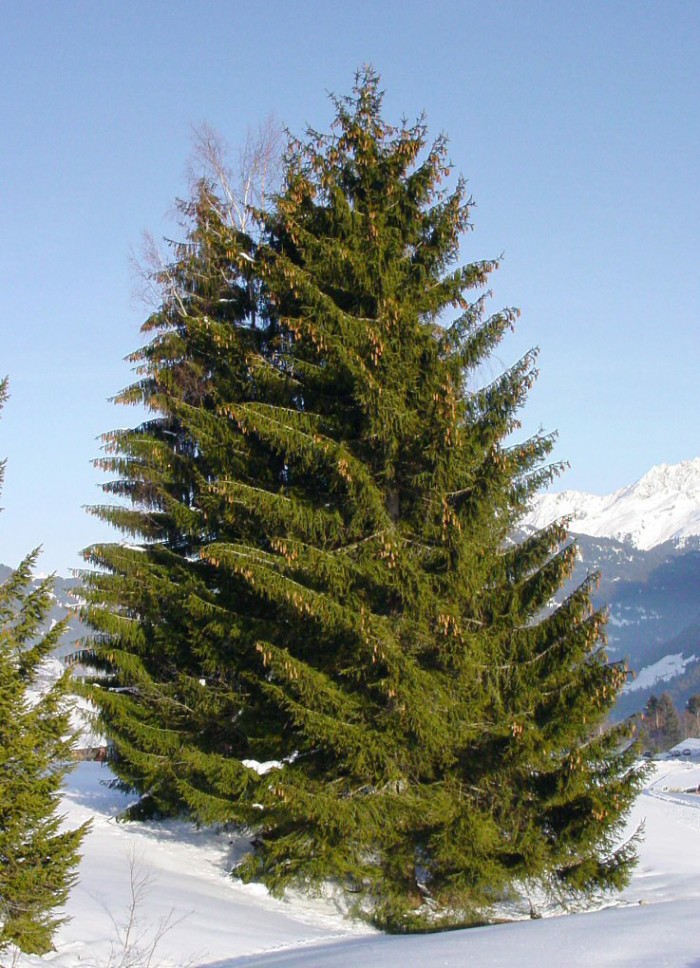Picea a genus of about 35 species of coniferous evergreen trees in the pine family (Pinaceae) that are found in the northern temperate and boreal regions of the earth. Spruces are large trees, from 60 to 200 feet (20 - 60 m) tall when mature, and can be distinguished by their whorled branches and conical form. The needles, or leaves, of spruce trees are attached singly to the branches in a spiral fashion, each needle on a small peg-like structure called a pulvinus. The needles are shed when 4 to 10 years old, leaving the branches rough with the retained pulvinus (an easy means of distinguishing them from other similar genera, where the branches are fairly smooth).
Spruces are used as food plants by the larvae of some Lepidoptera species but also used by the larvae of gall adelgids

In the mountains of western Sweden scientists have found a Norway spruce tree (Picea abies), nicknamed Old Tjikko, which by reproducing through layering has reached an age of 9,550 years and is claimed to be the world's oldest known living tree.
DNA analyses have shown that traditional classifications based on the morphology of needle and cone are artificial. A recent study found that Brewer spruce (P. breweriana) had a basal position, followed by Sitka spruce (P. sitchensis), and the other species were further divided into three clades, suggesting that Picea originated in North America.
Spruce is useful as a building wood, commonly referred to by several different names including North American timber, SPF (spruce, pine, fir) and whitewood. Spruce wood is used for many purposes, ranging from general construction work and crates to highly specialized uses in wooden aircraft, and as a tonewood in many musical instruments, including guitars, mandolins, cellos, violins, and the soundboard at the heart of a piano and the harp. The Wright brothers' first aircraft, the Flyer, was built of spruce.
Because this species has no insect or decay resistance qualities after logging, it is generally recommended for construction purposes as indoor use only (for example, indoor drywall framing). Spruce wood, when left outside cannot be expected to last more than 12 to 18 months depending on the type of climate it is exposed to.
Spruce is one of the most important woods for paper uses, as it has long wood fibers which bind together to make strong paper. The fibers are thin walled and collapse to thin bands upon drying. Spruces are commonly used in mechanical pulping as they are easily bleached. Together with northern pines, northern spruces are commonly used to make NBSK, a craft paper. Spruces are cultivated over vast areas as pulpwood.
The fresh shoots of many spruces and pines are a natural source of vitamin C. Captain Cook made alcoholic sugar-based spruce beer during his sea voyages in order to prevent scurvy in his crew. The leaves and branches, or the essential oils, can be used to brew spruce beer today.
In survival situations spruce needles can be directly ingested or boiled into a tea. This replaces large amounts of vitamin C. Also, it is believed that water stored in a spruce's needles can provide an alternative means of hydration. The resin was used in the manufacture of pitch in the past (before the use of petrochemicals); the scientific name Picea is generally thought to be derived from Latin pix, pitch (though other etymologies have been suggested).
Native Americans in North America use the thin, pliable roots of some species for weaving baskets and for sewing together pieces of birch bark for canoes. Spruces are also popular ornamental trees in horticulture, admired for their evergreen, symmetrical narrow-conic growth habit. For the same reason, some (particularly Picea abies and Picea omorika) are also extensively used as Christmas trees.
The word "spruce" entered the English language from Old French pruce, the name of Prussia. Spruce was a generic term for commodities brought to England by Hanseatic merchants and the tree was believed to have come from Prussia. According to a different theory, some suggest that it may, however, be a direct loanword from a Polish expression "drzewo" which literally means "tree from Prussia." That would suggest that the late medieval Polish-speaking merchants would export the timber to England and the English would pick up the expression from them.